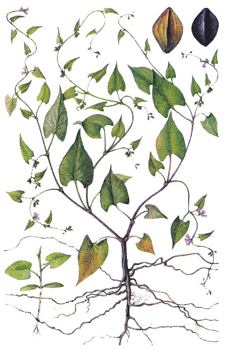Weeds
Fallopia convolvulus (L). A. Love - Climbing (Black) bindweed (Wild buckweed).
Taxonomy.
The family Polygonaceae Juss., genus Fallopia Adans.Synonyms.
Polygonum convolvulus L., Fagopyrum convolvulus (L). H. Gross, Reynoutria convolvulus (L). Shinners).Morphology and biology.
An early summer eutherophyte. Caulis climbing, 10-100 cm, branching from the base. Leaves triangular-ovoid with sagittate-cordiform base, with long petioles. Perianth 5-segmented, green from outside, white inside, up to 2-3 mm, with fruits up to 5 mm. Ovaries with 1 short stylus and 3 stigma. Flowers are arranged by 2-6 in axillae of leaves or on stem tips in sparse spiciform interrupted panicles. The fruit is triquetrous nutlet, regularly triangular on a transverse section, 3 mm in length and 2 mm in width, black, dull, with drawn-out pointed apex, included in perianth, and breaking off together with the last one at maturation. Blooms from June until September, bears fruit from July until September. Reproduction by seeds only, the number of seeds may be up to 640 on a plant. Seeds germinate in March-May. Seeds having endured frost in soil germinate faster than those kept under dry conditions. Minimum temperature of germination, +2 - 4°C, optimum +14 - 16°C, maximum +35°C.Distribution.
Everywhere in northern hemisphere. All western Europe, almost whole extratropical Asia, Northern America, Northern Africa (circumboreal species).Ecology.
Moderately thermophilic species occurring most often in forest zone and in northern forest-steppe zone. Grows in fields, including fallows and abandoned lands, in gardens, kitchen gardens and ruderal places, on weedy meadows and forest clearings, along sides of reservoirs. It is copious on rich and quite rich soils, such as dark-chestnut, black-earth, turfy, podsolic, derno-podsolic, brown forest soils. Prefers conditions of moderate humidification (with an amount of annual precipitation not less than 300 mm). Avoids strongly gleyic and peat soils.Economic significance.
One of the major weeds of all agricultural crops, especially of grain-crops and vegetables. The caulis twining round cultural plants, especially stems of cereals, intensifies their lodging. Control measures include careful clearing of a seed stock, use of a winter-annual grain, tilled crops and perennial fodder grass rotation, careful treatment of fallows; early autumn and well-timed spring treatment of soil.Reference citations:
Agaev M.G., ed. 1988. The main weed plants of agricultural crops in the Leningrad Region. In: Catalogue of a world collection of VIR. Issue 468. Leningrad: VIR. 13 p. (In Russian)Keller B.A., ed. 1934. Weed plants of the USSR. Leningrad: AN SSSR. V. 2: 74-76. (In Russian)
Mal.tsev A.I. 1937. The atlas of major species of weed plants of the USSR. Moscow-Leningrad: Sel.khozgiz. V. 1: 39-42. (In Russian)
Ramenskii L.G., Tsatsenkin I.A., Chizhikov O.N., Antipin N.A. 1956. An ecological estimation of fodder lands by vegetative covering. Moscow: Selkhozgiz. 472 pp. (In Russian)
Tsvelev N.N. 2000. A key to vascular plants of Northwestern Russia (Leningrad, Pskov and Novgorod Regions). Saint Petersburg. 352 p. (In Russian)
Ul.yanova T.N. 1998. Weed plants in flora of Russia and other countries of CIS. Saint Petersburg. 343 p. (In Russian)


